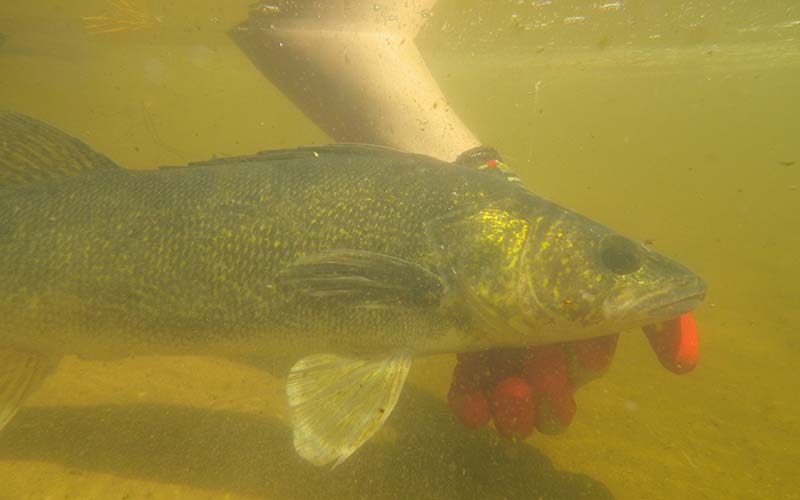John Kaman is president of the Big Sissabagama Lake Association. Dan Ersel and Jerome McAllister are board members.
Who are you/what is your role?
John: I’m John Kaman and we’ve been up here on Sissabagama since 2002. I’ve been associated with the lake association since 2014 and been president since 2017.
Dan: I’ve been on the lake since 1983, part time, until 2004. Then we bought a cabin on the lake which we are currently at. And I’ve been on the lake association for a couple months.
Jerome: I’m Jerome McCallister. I’ve owned a cabin on the lake since 1993. I’m very active with the Wisconsin Department of Natural Resources (WDNR) helping with grouse habitat. I’m also a grouse hunter.
What changes have you seen on the lake since you’ve been there?

John: I’m not specifically a walleye fisherman. I love casting the shoreline for bass, northern, that sort of thing. Occasionally I fish for a walleye but not that often and most of the information that I would have would be from other people on the lake complaining about the lack of walleye over the years. Supposedly the lake was quite good 20 to 25 years ago for walleye and people now are saying “oh my god, I don’t know where they went, what happened with the stocking, they’re not there anymore.”
Dan: Yes, when we first got here, we used to go out every night walleye fishing. I don’t know what the limit was back then but we used to get a nice pile. Now you can go out there for days and you’re lucky if you get three walleyes. We actually quit fishing them. I have a question though. Five to seven years ago the lake association, and I was a donor for this, we put $27,000 worth of walleye fingerlings out there. Where are they? The Wisconsin Department of Natural Resources staff, Max Wolter, said 10 percent of those would live.
Jerome: I think the lake has gotten clearer. I don’t know if we have done anything to cause that change. It’s also gotten weedier over the last 20 years and we’re having more frequent algae blooms. In the ’90s it was easy to catch walleyes. You could catch them in the morning before the sun hit the water, which is pretty late. And you could catch them in the evening before it actually got dark. I tried fishing in the weeds, because I had heard they disappeared from their usual habitat, but I never could figure out how to fish walleye in weeds. I gave up about five or six years ago. We did that stocking from about 2006 to 2008, and, I agree they disappeared.
Jerome: I think it was really dark from the tannin in the early 2000s and I think that came from the large tamarack trees. I think it’s less brown so you can see farther into it now.
Jerome: We stocked with our own money and got additional walleyes donated from Walleyes Forever and also from the Indian reservation east of Hayward. And we did all that over a period of three years.
Have you done any habitat restoration projects on the lake?
John: What we’ve done the last four years is trying to prevent the aquatic invasive species. On the weekends we’re part of the Wisconsin Department of Natural Resources program, Clean Boats, Clean Water. There’s two people that we pay to sit at the Wisconsin Department of Natural Resources boat dock on Saturdays and Sundays. That’s what we’ve been doing for three or four years now to inform people that zebra mussels are a problem and please look at your boats before you put them in the lake.
Jerome: One thing we’ve done throughout the 28 years I’ve been here is to measure water quality. The water quality has been pretty steady and really good throughout that 28-year period. But the water clarity has changed. It’s much clearer.
From what you’re seeing do you have hope for the future in terms of the lake and being able to continue to recreate on it the way that you have expected to?
Jerome: I don’t have any expectation for the fishing. It’s just gotten progressively worse. The muskie fishing goes up and down a little bit, they’re always hard to catch though.
Dan: Yeah, I’m with Jerry. You’re not going to walleye fish because you should be able to catch them and there’s none there.
Jerome: Probably the biggest change in the walleye fishing is that the first five years I was here, ’93 to ’97, the DNR would come to our annual meetings and they would not stock this lake with walleyes, not any kind of walleyes. They said it was the best naturally reproducing lake in northwest Wisconsin. They said there wasn’t any reason to do anything about it. By 2006 they had all disappeared, just like now. That happened within about a 10-year span and that’s when we spent that $27,000 dollars, which appeared to do little good.
The views and opinions expressed in this interview are those of the authors and do not represent official policy or position of the University of Wisconsin-Madison or the Wisconsin Initiative on Climate Change Impacts.